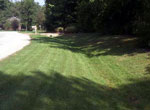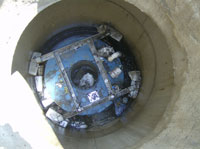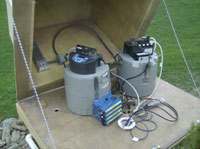
Structural vs. Natural Runoff Solutions
Putting natural solutions to the test would help experts further refine BMPs for stormwater runoff
- By John MacKinnon
- Oct 21, 2009
Here’s one point on which all stormwater experts agree: Our planet needs to marshal all of its forces to manage the stormwater that is running off our developments and into our waterways. The debate is over how to do that.
In the past, the theory of getting runoff away from a site as quickly as possible was at the forefront of stormwater design.

Downstream Defender test unit.
Now, the thinking is to keep a site’s post-construction runoff on site in order to maintain, as close as possible, pre-construction hydrology. This theory is the cornerstone of Low Impact Development, or LID, the hottest buzzword in the industry. Integrated management practices, incorporating natural solutions that are sometimes complemented with proprietary products that enhance on-site retention and infiltration of stormwater, provide a means by which post-construction hydrology can resemble pre-construction hydrology while ferreting out sediment, nutrients, hydrocarbons and metals.
Here’s another point of consensus: Systems that treat stormwater must perform well and provide the highest degree of reliability possible. To ensure this, sites must undergo rigorous hydraulic modeling as part of the stormwater permit application, and the pollutant removal performance of treatment best management practices (BMPs) must be tested – rigorously. Treatment BMPs must pass these tests and measure up to high standards set by regulatory agencies.
The absence of a nationwide stormwater management standard, coupled with the different rainfall patterns, pollutants of concern, environmental resources and economic drivers from state to state, has resulted in a wide disparity among stormwater management programs. Fittingly, the disparity between stormwater management programs has resulted in a wide disparity in stormwater BMP performance verification standards.
A handful of highly rigorous stormwater verification protocols such as TAPE, the protocol championed by the Washington Department of Ecology, and TARP, the protocol of a handful of mostly eastern states such as New Jersey and Massachusetts, have emerged over the past decade. Suppliers of manufactured stormwater BMPs have been investing heavily in such verification programs, growing increasingly aware of the strengths and limitations of their systems under different rainfall and pollutant loading conditions.

Automatic Samplers.
Manufactured stormwater treatment systems differ from natural practices inasmuch as they are typically proprietary and almost always structural. A specialized group of equipment suppliers located throughout the industrialized countries of the world provide such technologies as screening, sedimentation, hydrodynamic separation, filtration, absorption and adsorption to remove pollutants. It is a highly competitive business, where due to rapidly changing regulations, a supplier’s engineers and scientists must continually innovate in order to offer solutions to the market that meet the needs of rapidly changing stormwater regulations. Natural practices include bioretention basins, bioswales, rain gardens and infiltration trenches.
As the uptake of LID design philosophy (integrating structural and natural stormwater practices) continues to grow, we (equipment suppliers) are finding ourselves in a perplexing condition. After nearly a decade of continuous performance verification programs intended to improve the effectiveness of stormwater management programs we are implementing every day, the strengths and limitations of manufactured stormwater systems are increasingly well understood while, generally, those of natural stormwater systems are not.
To be approved by regulatory agencies in many parts of the United States, manufactured systems must be field tested for more than a year at sites that produce stormwater runoff representative of regional climate and pollutant load. Storms must meet certain characteristics (e.g., rainfall depth and intensity) before they can be considered as “qualifying events.” Samples are automatically collected at the inlet and the outlet at pre-set intervals (that is., after a given volume of water flows past the sampler) during a storm, and the samples are composited to create “flow-weighted” inlet and outlet samples. The two samples are then compared to judge the amount of pollutants that are removed by the manufactured system. The systems are also monitored to establish their maintenance interval, as determined when accumulated pollutants are adversely affecting performance. Regulatory agency approvals based on test results are very specific on the use of a manufactured system within their jurisdiction.
In general, natural practices have not experienced the same level of rigorous testing. Many laypeople believe that because these practices use primarily natural materials and attempt to replicate the natural environment, they can basically take care of themselves. Their very nature poses more testing challenges ─ oftentimes, there is no identifiable inlet to a natural practice because stormwater enters from many different directions. A device designed to collect and channel inlet flow to a single sampling point may be required to collect sufficient sample volume for analysis. Similarly, the collection of an effluent sample can be problematic where there is no discernable outlet, as is the case with infiltration practices.
While natural practices may have design “formulas,” they are constructed in various configurations with unique inlet and/or outlet configurations or types of pretreatment (if any) and use locally available natural materials (e.g., soil and plants). Although consultants are learning how to overcome many of the challenges associated with testing natural practices, the lack of standardization in design and construction renders it difficult to relate performance data from a single installation to the performance of natural practices across the country.
And, too, the drivers for testing natural practices are limited. Money to pay for the sampling and analysis of a non-proprietary, natural BMP, which is not cheap, typically comes from university grants or government programs.
The continued performance evaluation of manufactured systems has brought many benefits to the stormwater treatment industry. Manufacturers are using the knowledge they’ve gained to create innovative new products and processes. For proof of this innovation, look no farther than the recent launch of proprietary filtration systems, biofiltration systems and infiltration systems.
The science of stormwater treatment would benefit further by applying the same kinds of testing protocols to natural systems. Testing should be performed regionally, as it is with manufactured systems, to take into account regional conditions. Designs should be standardized as much as possible and local materials used in the construction of the installation being tested. Natural practices should be tested for at least one year using storms that meet criteria for qualifying events and monitored to establish maintenance intervals.
Everyone would benefit from testing all stormwater treatment systems and practices according to the same protocol. Rather than relying on anecdotal evidence, regulators, engineers, contractors and site owners would be able to compare the attributes of both methods of stormwater treatment when determining which method is both feasible and cost-effective for a site. Engineered and natural systems are both essential tools in stormwater treatment. Putting both methods to the test can only improve their effectiveness, which will help in the ongoing fight to save our watercourses.
About the Author
John MacKinnon is a regulatory specialist at Hydro International.